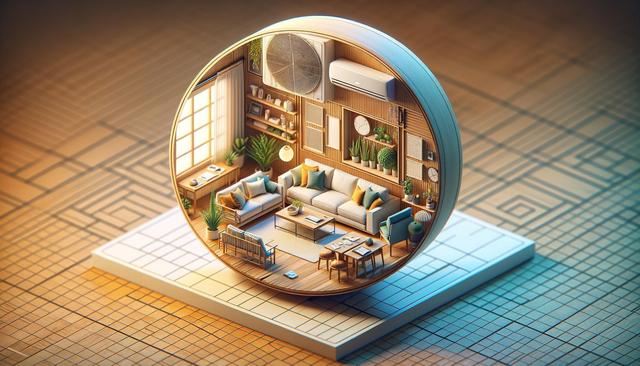Understanding How Ductless AC Works
Ductless air conditioning systems, also known as mini-split systems, consist of two main components: an outdoor compressor unit and one or more indoor air-handling units. These units are connected by a conduit that houses the power cable, refrigerant tubing, and a condensate drain. This setup allows for targeted cooling in individual rooms without relying on extensive ductwork. Learning how ductless AC works highlights the core benefits of these systems—namely, their flexibility and energy efficiency. One of the most appealing aspects is the ability to independently control the temperature in different zones, which can be particularly useful in homes with varying cooling needs across spaces.
Because there are no ducts, there are fewer opportunities for energy loss, a common issue in traditional systems. This not only reduces electricity usage but also enhances cooling efficiency. For those interested in more technical details, the indoor units pull warm air from the room, cool it using a refrigerant cycle, and then release it back into the space. This process is highly effective and allows for precise climate control, making ductless systems a smart solution for modern homes.
Energy Efficiency and Environmental Benefits
Energy-efficient ductless systems are gaining popularity for good reason. These systems are designed to reduce energy consumption while delivering reliable performance. Unlike conventional HVAC systems that may cool an entire home even when only one room is occupied, ductless units allow for zoned cooling. This means you can control the temperature of specific areas, avoiding unnecessary energy use in unoccupied spaces.
Some of the key features that enhance the energy efficiency of ductless systems include:
- Inverter technology that adjusts compressor speed based on the cooling demand
- Programmable thermostats for better control
- Multi-zone capabilities to customize comfort levels
These systems often meet or exceed ENERGY STAR guidelines, helping reduce both your carbon footprint and your utility bills. For homeowners focused on sustainability, this can be a major incentive. Additionally, the absence of ductwork means fewer opportunities for dust and allergens to circulate, improving indoor air quality along with energy performance.
Installation and Cost Considerations
One of the most frequently asked questions revolves around the cost of ductless AC installation. While the initial investment may be higher than that of a window unit or portable AC, ductless systems typically offer long-term savings through lower energy bills and minimal maintenance. Installation costs can vary based on factors such as the number of indoor units required, the complexity of the setup, and regional labor rates.
Here’s a basic breakdown of cost-related factors:
- Number of zones or rooms needing cooling
- Type and brand of the ductless system
- Installation complexity and materials required
Working with a qualified HVAC professional can help ensure accurate installation estimates and proper system sizing. Although the upfront cost might seem significant, many homeowners find that the savings on energy bills and the convenience of zoned temperature control make it a valuable investment. Exploring the best ductless AC brands can also help you identify options that balance performance, efficiency, and affordability.
Maintenance Tips for Long-Term Performance
To keep your ductless system running efficiently, regular upkeep is essential. Ductless AC maintenance tips include checking filters, cleaning coils, and ensuring the outdoor unit remains free of debris. Unlike traditional HVAC systems, ductless units are relatively easy to maintain, which makes them ideal for homeowners who prefer low-maintenance solutions.
Here are some key maintenance practices:
- Clean or replace filters every 1–2 months
- Inspect and clean the indoor and outdoor units regularly
- Schedule professional maintenance annually
- Check for any refrigerant leaks or unusual noises
Following these simple steps can extend the lifespan of your system and maintain its efficiency. Additionally, keeping up with maintenance helps prevent minor issues from turning into costly repairs. Learning how to handle basic upkeep can save time and ensure consistent performance throughout the year.
Troubleshooting and Common Issues
No system is without its occasional hiccups, and understanding how to approach troubleshooting ductless AC issues can help you address problems quickly. Common issues include reduced cooling performance, unusual noises, or error codes on the indoor unit display. While minor issues can often be resolved by cleaning filters or resetting the system, more complex problems may require professional attention.
Some typical signs that your system might need servicing include:
- Weak airflow from the indoor unit
- Inconsistent temperatures in different zones
- Water leaks near the indoor unit
- Unusual odors or operational noises
Many of these problems stem from neglected maintenance or minor mechanical issues. Fortunately, most ductless systems come with diagnostic features that help identify faults. If you experience persistent issues, it’s advisable to contact a certified technician who is familiar with your system’s brand and model. Staying informed about how ductless AC works can also make it easier to communicate with service professionals and understand recommended repairs.
Conclusion: Why a Ductless AC Upgrade Makes Sense
For homeowners considering a cooling upgrade, ductless air conditioning systems offer a compelling combination of energy efficiency, flexible installation, and reliable performance. Whether you’re looking to enhance comfort in a single room or need a whole-home solution without the disruption of ductwork, ductless units are a practical and modern choice.
With an understanding of how ductless AC works, the benefits of energy-efficient ductless systems, and the importance of proper upkeep, you’re better equipped to make an informed decision. Explore the best ductless AC brands, understand the cost of ductless AC installation, and stay on top of ductless AC maintenance tips to get the most out of your investment. If issues arise, knowing how to approach troubleshooting ductless AC issues can save both time and cost. Ultimately, upgrading to a ductless system can offer lasting comfort with minimal hassle.



Leave a Reply